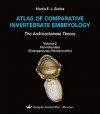![Atlas of Comparative Invertebrate Embryology, Volume 2: Hemichordata (Enteropneusta, Pterobranchia) Atlas of Comparative Invertebrate Embryology, Volume 2: Hemichordata (Enteropneusta, Pterobranchia)]()
Click to have a closer look
About this book
Contents
Customer reviews
Related titles
About this book
The Atlas of Comparative Invertebrate Embryology has two aims. Firstly, it describes embryonic development or ontogeny of several species within a phylum. Secondly, by comparing the different ontogenies this collection supplies a basis for phylogenetic reflections about phylum-level relationships in lower Metazoa. Diversity of ontogenies, embryos and larvae can be an important source for well-founded phylogenetic theories. Like comparative morphology and anatomy, comparative embryology plays a central role for the analysis of evolution.
The Atlas of Comparative Invertebrate Embryology presents a wealth of embryonic and larval developmental processes to emphasize the great variety of ontogenies in the animal kingdom. Like the adult organisms, larvae are also of an enormous diversity owing to the varied requirements of their environment. Within a phylum, embryonic and larval development may be uniform to a large degree, but also deviations are known. In comparing the different ontogenies of an animal phylum, embryologists try to find out the common ancestor and to reconstruct the phylogeny of the group.
Establishing a phylogenetic system of the animal kingdom on the basis of comparative embryology requires a sound theory to integrate far reaching steps in evolution of the animal phyla. Two theories, which are founded in simple events that equally occur in many embryonic developmental courses of different phyla, are the Gastraea–theory of Haeckel (1874) and the Archicoelomata–theory of Masterman (1898). In the Atlas of Comparative Invertebrate Embryology, the phylogenetic system proposed by comparison of the different ontogenies is based on these two theories.
The atlas offers a broad view about the diversity of embryos and larvae and may be useful in looking for a suitable species of special interest. Naturally, an exhaustive description of all ontogenies of animals is impossible. Ontogenies of well known species and detailed research work of their embryos have been chosen. Besides this, embryological research work of some Metazoan phyla is incomplete. Our knowledge of the ontogeny of animals is mainly founded on the classical investigations between 1860 and 1960. In the Atlas of Comparative Invertebrate Embryology, in the chapters concerning phylogenetic interrelationships of phyla, results of studies on morphological or biochemical composition of structures of the adults and of modern gene sequence data may be included into discussion.
Contents
Triploblastic Organisms – Animals with three germ layers 7
Archicoelomata 7
Phylum Hemichordata 7
Class Enteropneusta 8
Ptychoderidae 8
Balanoglossus clavigerus (DELLE CHIAJE) 8
Ptychodera bahamensis (SPENGEL) 12
Ptychodera flava laysanica (SPENGEL) 19
Glossobalanus minutus (KOWALEVSKY) 22
Spengeliidae 22
Glandiceps stiasnyi (RAO) 22
Harrimaniidae 25
Saccoglossus kowalevskii (AGASSIZ) 25
Saccoglossus otagoensis (BENHAM) 32
Saccoglossus horsti (BRAMBELL & GOODHART) 33
Summary of Ontogenesis in Enteropneusta 37
Cleavage, gastrulation and mesoderm formation 37
Larvae 38
Embryonic development in Enteropneusta and evolutionary interpretation 40
Formation of the mesoderm germ layer 40
Tornaria larva 40
Class-level relationship of Enteropneusta 40
Literature 41
Class Pterobranchia 43
Rhabdopleurida 43
Rhabdopleura normani (ALLMAN) 43
Rhapdopleura compacta (HINCKS) 47
Cephalodiscus gilchristi (RIDEWOOD) 50
Cephalodiscus indicus (SCHEPOTIEFF) and Cephalodiscus nigrescens (LANKESTER) 53
Summary of Ontogenesis in Pterobranchia 54
Cleavage, gastrulation and mesoderm formation 54
“Larvae” 54
Embryonic development in Pterobranchia, larval and adult morphology, and evolutionary interpretation 55
Embryology 55
Larval and adult morphology and class-level relationship of Pterobranchia 55
Prosoma 55
Mesosoma 56
Metasoma 56
Literature 57
Phylum Level Relationships of Hemichordata 59
Larval types 59
Larval and adult morphology 59
Prosoma 59
Heart-glomerulus complex in hemichordates 59
Heart-glomerulus complex in echinoderms 61
Stomochord 62
Preoral ciliary organ 62
Mesosoma 63
Nervous system 63
Lophophore 63
Lophophore and molecular systematics 64
Metasoma 64
Gill slits 64
Summary 66
Literature 67
Glossary 70
Customer Reviews









































